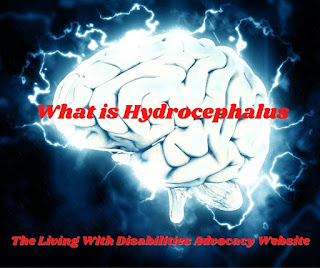What is Hydrocephalus
First, welcome to the Living With Disabilities Advocacy Website. It's run by none other than Katrina Smith, who's a person with a learning disability. Her mission behind Living With Disabilities is to bring awareness to all people with disabilities.
Today, Living With Disabilities wants to talk about what is Hydrocephalus.
Hydrocephalus is due to a fluid build-up in the cavities within the brain.
Cerebrospinal fluid usually flows through the ventricles chambers and bathes the brain and spinal column. But the pressure of too much cerebrospinal fluid linked with hydrocephalus can harm the brain tissues and cause a range of brain function problems.
The additional fluid puts pressure on the brain and can cause brain damage. Hydrocephalus can happen at any age, It's most common in infants and adults over sixty and over. Operation for hydrocephalus can restore and maintain normal spinal fluid levels in the brain. Various therapies are often required to control symptoms or problems resulting from hydrocephalus.
Symptoms
The symptoms and signs of hydrocephalus vary slightly by age and onset.
Infancy
Hydrocephalus signs and symptoms in Infants include:
Transformation in head size.
- An unusually large head.
- A rapid growth in the head size.
- A swollen or tense soft spot (crown) on the top of the head.
Physical signs and symptoms
- Queasiness and vomiting.
- Sleepiness or sluggishness.
- Irritability.
- Poor eating.
- Seizures.
- Sunsetting eyes (eyes looking downward).
- Muscles and strength toning problem.
Toddlers and Older children
Amongst toddlers and older children
- Headache.
- Vision issues (blurred or double vision).
- Unusual eye movement.
- Unusual enlargement of toddler's head.
- Sleepiness or sluggishness.
- Queasiness and vomitting.
- Unsteady balance.
- Poor coordination.
- Poor appetite.
- Loss of bladder control or often urination.
Common signs and symptoms include:
- Headaches.
- sluggishness.
- loss of coordinations or blances.
- Loss of bladder control or frequent urge to urinate.
- Vision problems.
- The decline in memory, concentration, and other memory skills affects job performance.
- Loss of bladder control or frequent urge to urinate.
- Memory loss.
- Gradual loss of thinking or reasoning skills.
- Walking difficulty, shuffling gait, or feeling of the feet being stuck.
- Poor coordination or balance.
When to see a physician
Seeking urgent medical care for Infants and toddlers with the following signs and symptoms:
- A high-pitched crying.
- problems with sucking or feeding.
- Unexplained, recurrent vomiting.
- Seizures.
Seek induced medical attention for any other signs or symptoms in other age groups.
Hydrocephalus has one or more conditions that can cause the problem associated. So, it's important to get a timely diagnosis and appropriate care.
Causes
Hydrocephalus is caused by an imbalance between how much cerebrospinal fluid is produced and how much is absorbed into the bloodstream.
Cerebrospinal fluid is produced by tissues lining the ventricles of the brain. It flows through the ventricles chamber by way of interconnecting channels. The fluid eventually flows into spaces around the brain and spinal column. It's absorbed primarily by blood vessels in tissues on the surface of the brain.
The cerebrospinal fluid plays an important role in brain functions by:
- Keeping the brain happy, allowing the relatively heavy brain to float within the skull.
- Cushioning the brain to prevent injury.
- Remove waste products from the brain's metabolism.
- Flowing back and forth between the brain cavity and spinal column to maintain a constant pressure within the brain--- offsetting for changes in blood pressure in the brain.
Too much cerebrospinal fluid in the ventricles chamber occurs for one of the following reasons:
- Obstruction The most common issue is a partial blockage of the flow of cerebrospinal fluid, either from one ventricle chamber to another or from the ventricles to other spaces around the brain.
- Poor absorption Less common issue with absorbing cerebrospinal fluid. This is often related to inflammation of brain tissues from disease or injury.
- Overproduction Seldomly, cerebrospinal fluid is created more quickly than it can be absorbed.
Risk Factor
Infant
Hydrocephalus present at birth or shortly after birth can occur because of any of the following:
- Unusual development of the central nervous system can obstruct the flow of cerebrospinal fluid.
- Bleeding within the ventricle chambers is a possible complication of premature birth.
- Infection in the uterus--- in particular rubella or syphilis---during pregnancy, can cause inflammation in fetal brain tissues.
Other determining factors
- Lesions or tumors of the brain or spinal cord.
- Central nervous system infections, such as bacterial meningitis or mumps.
- Bleeding from a stroke or head injury.
- Other traumatic injuries to the brain.
- Your answers to your doctor's questions about signs and symptoms.
- A general physical examination.
- A neurological examination.
- A brain-imaging test.
Brain Imaging
Test image that can help diagnose hydrocephalus and identify underlying causes of the symptoms:
- Ultrasound This test often is used for an initial assessment of infants because it's a relatively simple, low-risk procedure. An ultrasound device is placed over the soft spot on the top of an Infant's head. The ultrasound might also detect hydrocephalus before birth during routine prenatal examinations.
- MRI This test uses radio waves and a magnetic field to produce detailed images of the brain. This test is painless, yet it's noisy and requires lying still. MRI scans can show enlarged ventricle chambers caused by excess cerebrospinal fluid. They can also be used to identify the causes of hydrocephalus or other conditions contributing to the symptoms. Children might need mild sedation for some MRI scans. However, some hospitals use a fast version of MRI that generally doesn't require sedation.
CT scan This x-ray technology produces cross-sectional views of the brain. Scanning is painless and fast. yet this test requires lying still, so a child usually receives a mild sedative.
CT scanning produces less detailed images than MRI does and causes exposure to a small amount of radiation. CT scans for hydrocephalus are usually used only for emergency exams.
Complications of Surgery
Both surgical procedures can result in complications. The shunt systems can stop draining cerebrospinal fluid or poorly regulate drainage because of mechanical problems, blockage, or infections. Complications of Ventriculostomy include bleeding and infections.
Any failure requires prompt attention, surgical revision, or other interventions. Fever or recurrence of the original symptoms of hydrocephalus should prompt an appointment with the doctor.
Additional treatments
Some people with hydrocephalus particularly children might need additional treatment, depending on the severity of long-term complications of hydrocephalus.
The children's care team might include the following:
- Pediatrician or physiatrist, who can oversee the treatment plan and medical care.
- Pediatric neurologist, who can specialize in the diagnosis and treatment of neurological disorders in children.
- Occupational therapist, who can specialize in therapy to develop everyday skills.
- Developmental therapist, who specializes in therapy to help the child develop age-appropriate behaviors, social skills, and interpersonal skills.
- Mental health professional, Such as a psychologist, or psychiatrist.
- Social worker, Who assists the family with getting needed services and planning for transitions in care.
Children who are in will likely need special education teachers, who address learning disabilities, determine educational needs, and identify needed resources.
Adult-Care
Adults with more-severe complications also might need the services of occupational therapists, Social workers, Specialists in dementia care, or other medical specialists.
Complexity
https://anchor.fm/livingwithdisabilites/episodes/What-is-Hydrocephalus-e1hui2j




Comments
Post a Comment